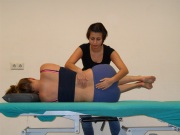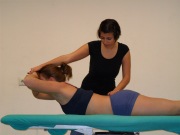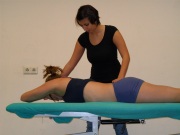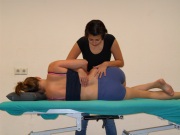Performing passive movements in the lumbar spine may be difficult, as the therapist needs to move the heavy trunk and/or lower limbs.Therefore, joint play movements often replace the passive movements. When performing these movements, any decreased ROM, pain, or changes in end feel should be noted (Magee, 2006).
Flexion: patient is in side lying position, with knees and hips at 90 degrees. Therapist palpates between the spinous processes using three fingers; one above the spinous process, one on and one below the process. The therapist then uses their body weight to perform a flexing movement in the lumbar spine, and feels for the ‘gapping’ during the movement, noting if the movement is normal, hypo or hypermobile. Results depend on the ability of the therapist, as the test shows only average inter-rater reliability (Inscoe et al. 1995).
Extension: patient lies prone, with arms crossed and head resting on the hands. The therapist uses the crossed arms to pull the patient’s trunk upwards, while feeling the movements of the spinous processes and noting normal, hypo or hypermobility.
k
k
Side Flexion: patient lies prone, in same position as extension. The therapist again uses the crossed arms to pull the patient’s trunk sidewards and notes the ‘gapping’ between the spinous processes and whether the movement is normal, hypo or hypermobile.
k
k
Rotation: patient in sidelying position, with hips and knees flexed and arms crossed. The therapist uses one hand to palpate the spinous process and the other arm on the hip to create the rotational movement, noting the movement as normal, hypo or hypermobile.
k
Patient history
Observation
Active range of motion (AROM)
Neurological testing



